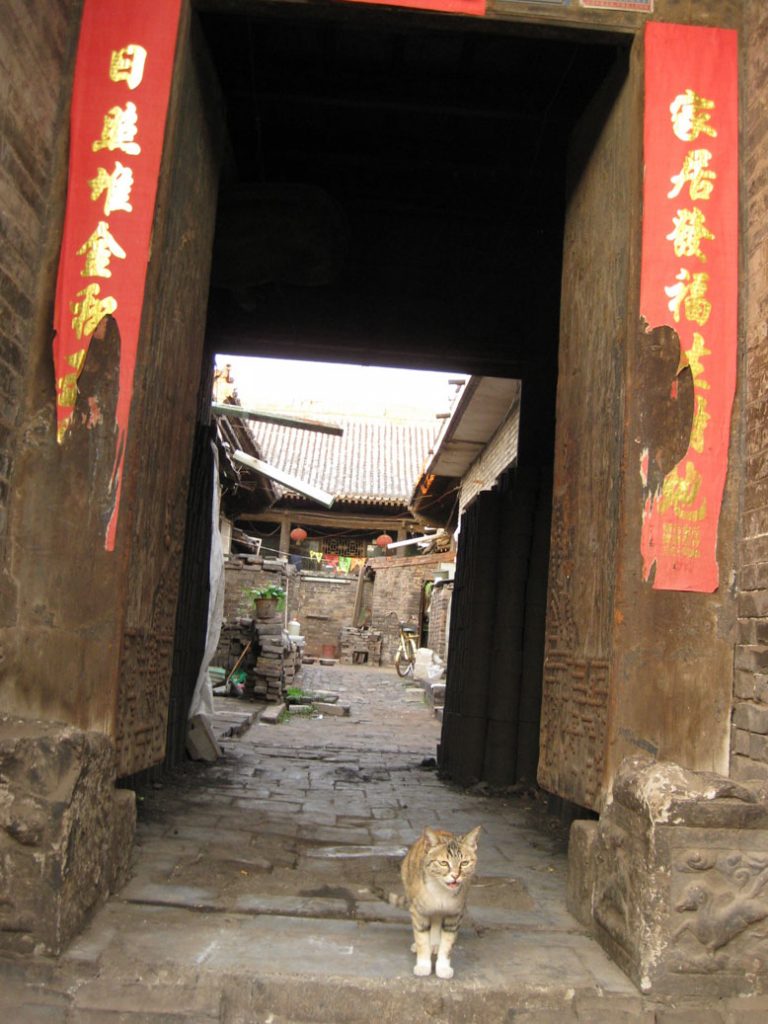 Tiny cobbled streets, ancient brick wall, UNESCO world heritage site, puppies and kittens roaming the streets: Pingyao had all the markers of a great place to visit. Often called ‘the best preserved city in China’ Pingyao, located about 700 km west of Beijing, deserves the stellar reputation. It is a small city, surrounded completely by a fully intact 60-foot wall, and stepping into the cobbled streets is like stepping back in time (if you ignore all the iphone texting, top quality camera using tourists that is.)
Tiny cobbled streets, ancient brick wall, UNESCO world heritage site, puppies and kittens roaming the streets: Pingyao had all the markers of a great place to visit. Often called ‘the best preserved city in China’ Pingyao, located about 700 km west of Beijing, deserves the stellar reputation. It is a small city, surrounded completely by a fully intact 60-foot wall, and stepping into the cobbled streets is like stepping back in time (if you ignore all the iphone texting, top quality camera using tourists that is.)
Pingyao grew to prominence in the Qing and Ming Dynasties, which makes most of the buildings and houses about 600 plus years old. You wouldn’t know it by looking at them though, as they have been greatly preserved over the centuries. Even spending the night in Pingyao is a treat as every hotel and hostel was originally a traditional home.

Homes back then were four sides with a courtyard in the middle, and hotels and even restaurants have transformed these traditional homes into places with modern appliances like flush toilets and air-conditioners. At night we would walk the streets and peer into the courtyards of restaurant to pick the nicest looking ones to eat in.
The outer wall has many watchtowers, and you can climb the wall and walk around it, but we didn’t feel like paying the 150 kuai admission fee to get onto the wall. Inside the city there are a few watchtowers as well, and for the low price of 5 yuan, we climbed the worn steps of one which also happened to be the tallest building inside the city. From atop the three story building you could look down and see many things happening inside the city. The sloping roofs of the traditional buildings go off into the distance and they have the distinct appearance of grey waves about to crash onto the unsuspecting tourists.

We saw some other things from above that we would miss at ground level, like a kitty sleeping in a big ‘antique’ bowl. (Pingyao shops are known for selling “antiques” and if you are looking for old postcards, bronze busts of Mao or slightly rusty chess pieces, this is the place to get them.) In the distance we could see tall buildings and construction cranes, signs that the city outside the wall growing larger and larger. A decade ago there wasn’t much outside the walls. Now, thanks to the city’s growing popularity, it is getting bigger and bigger.
Almost everything in Pingyao was built with Chinese architectural and cultural traditions in mind. The layout of the city was built according to feng shui principles: 4 main avenues, 8 smaller streets and 72 crisscrossing alleyways with the administrative offices in the center of the city. The wall (which is 6 km long) has 3,000 battlements and 72 bastions to represent Confucius’s 3,000 disciples and 72 sages.

Pingyao had the luck of becoming important in the banking world. The first bank in China opened here in 1823 (which some claim as the world’s first modern bank) and it became a prosperous place in which rich businessmen built all these amazing buildings and homes for their families.
Then they had even greater luck (in my mind) to fall into total disrepair and poverty when banking moved to bigger cities like Shanghai and Hong Kong. Why luck? Because the town was so destitute and impoverished the Red Guard didn’t even bother giving the city the time of day during the Cultural Revolution.
That’s how Pingyao became one of the best preserved towns in China (with the least amount of rebuilding). Nowadays it has come roaring back into prosperity thanks to tourism. (I felt like there were more foreign tourists in tiny Pingyao then all of Beijing.) And not just foreign tourists but dozens of Chinese tour groups with their members walking around in matching hats following flag-holding guides marching up and down the avenues and zipping about in electric go-carts.
You can get away from the other tourists, both Chinese and foreign, by walking around the alleys. They twist and snake in all directions and while it is easy to get turned around in the city, you can never really get lost, thanks to the 60-foot walls. As long as you don’t pass through the gate, you’ll never be too far from your hostel. The alleys see few tourists and are quiet. Life looks much like any other small town in China in the alleys: Old men sitting out in chairs talking, kids running, women hanging up the wash and kitties cleaning themselves in the patches of sun. You can even get an occasional peek into some open doorways to see more of the cities ancient architecture.
People say that as Pingyao grows the city is changing. It will go from small thriving town to ancient town theme park. I hope that doesn’t happen, that the locals won’t get pushed out of their homes to make way for tourism, but from what I saw, visiting in the summertime, it seemed like it might just do that. In the past, the walls were built to keep the enemies out and the residents safe. But now, in modern times, the enemy is attacking from within and slowly pushing the locals out. Funny that. I wonder what the ancestors who originally built this city would have to say about that.





Leave a Reply